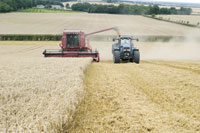Early wheat yields down 15% in RL trials

Wheat yields are about 15% down this season compared with rolling five-year mean in the first 10 HGCA Recommended List trials results to be released.
Those 10 trials did contain a higher proportion of second wheat trials than would be in the final list, which dragged down yields a little, Jim McVittie, RL trials manager pointed out.
“In the first wheats there have been some good yields of more than 11t/ha, and one poor at 7t/ha, and similarly in the second wheats three about 8-9t/ha and one at 5t/ha.
“It reflects what we are hearing commercially, that yields are variable from field-to-field.”
But with a higher wheat area in the ground the overall crop could still be as large as last year, he suggested.
Top yielding variety in this year’s trials is the potential Group 3 candidate Cocoon, which is being marketed by Masstock at 107% of the controls. It was one of four potential Group 3 varieties yielding at or just above current leader Invicta on the five-year mean, Dr McVittie said. The others are KWS Target, Tuxedo from RAGT and Senova’s Orbit.
“That’s encouraging, particularly when Claire is back up to 3% of the seed area, after being down at 1%.”
Three candidate soft feed wheats – Denman, Gravitas and KWS Gymnast are also at 103% of the controls on the long-term mean – just behind Beluga, which is in fewer trials this season.
“Distilling potential, which also gives a good marker for biofuels, and disease resistance are likely to be important.”
The highest overall yield is with candidate hard feed, KWS Santiago, which at 108% is 2% above Oakley and Conqueror, both also bred by KWS. “But Santiago is only a four for Septoria tritici, which you don’t see too often these days.”
In contrast, Stigg has the first eight for Septoria tritici resistance, but is 4% behind Oakley and Conqueror. That yield penalty was a bit more that growers had to pay for Warrior, which was only 2% below Invicta, in the Group 3 sector, Dr McVittie said. “But the disease resistance is a little better.”
Milling wheat Gallant was maintaining its 2% yield advantage over Solstice in this year’s trials, which was important for confidence as the millers would be using the variety day-to-day for the first time this season.
KWS Podium, a candidate milling wheat, was level with Gallant for yield, Dr McVittie added. “But we don’t know at this stage how it fits for quality.”

